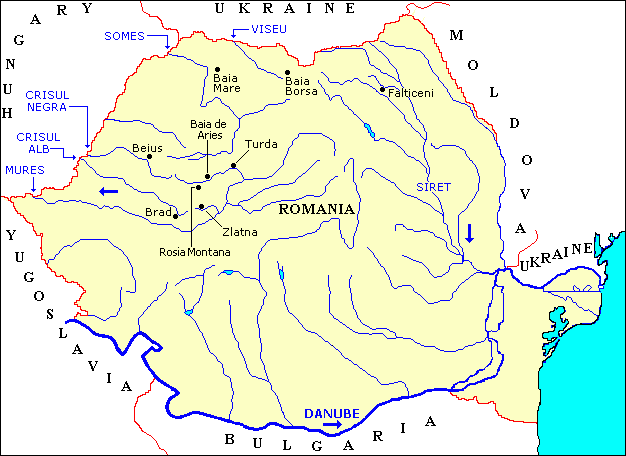
Display 1. Some of the prominent pollution-accident sites, and the major Romanian rivers that their contamination first enters on its way to the Danube Delta.
 Display 1. Some of the prominent pollution-accident sites, and the major Romanian rivers that their contamination first enters on its way to the Danube Delta. |
Although the spectacular fish kill resulting from the 30-Jan-2000 Baia Mare cyanide spill captured world attention, other toxic spills in Romania are readily discovered, as for example those in the list of fourteen below, whose waters all ultimately dump into the Danube. These 14 happen to start by contaminating one of six Romanian rivers labelled in Display 1. Viseu waters start off contaminating Ukraine and after that Hungary in a manner explained by the Tisza mosaic. The Somes, Crisul Negra, Crisul Alb, and Mures flow directly into Hungary, there to join the Tisza, which in turn joins the Danube in Yugoslavia, and by means of a counterclockwise trip through central Europe, their Romanian toxins finding opportunity to spread themselves over a large area before arriving at the Danube Delta diluted. Only the Siret is able to keep Romanian contamination within Romanian borders prior to reaching the Danube at a point not far above its delta, such that Siret toxins have less opportunity to become diluted before impacting the Danube Delta.
Below is a listing of the fourteen instances spoken of, with usually only a brief outline of each, except for the already-discussed 30-Jan-2000 Baia Mare spill, which is given more attention, and except for the addition of a few photographs that both clarify and assist in fixing in memory.
08-Feb-1998 Zlatna "All fish and micro-organisms
died"
Zlatna Andreas Bernstorff and Judit Kanthak, The Real Face of the Kangaroo, Greenpeace, March 2000 archive.greenpeace.org/toxics/reports/aurul-romania.pdf |
May-1998 Brad "Large quantities of water and sludge containing cyanide and heavy
metals were released"
Brad Andreas Bernstorff and Judit Kanthak, The Real Face of the Kangaroo, Greenpeace, March 2000 archive.greenpeace.org/toxics/reports/aurul-romania.pdf |
28-Dec-1999 Baia de Aries "All of the remaining,
already sparse, fish population died"
Baia de Aries Andreas Bernstorff and Judit Kanthak, The Real Face of the Kangaroo, Greenpeace, March 2000 archive.greenpeace.org/toxics/reports/aurul-romania.pdf |
30-Jan-2000 Baia Mare "Elevated CN was still measurable in the Danube Delta on the edge of the Black Sea four weeks after the spill"
Tailings Spill Accident in Baia Mare, Romania extensive contamination of a major river system, from the Somes/Szamos streams and the Tisza River, to the Danube River--contamination was detected for 2000 km downstream of the spill; contamination and interruption of the drinking water in 24 towns and of 2.5 million people;
massive fish-kill and destruction of aquatic species in the river systems; [...]
[...] Australian Government, Department of the Environment and Heritage www.deh.gov.au/industry/... |
HVG 17 February 2000 www.zpok.hu/cyanide/baiamare/docs/Report1702.htm |
06-Feb-2000 Bozinte Mare "1500 m3 of waste water with a cyanide concentration of 7mg/l reached the Lapus river"
Bozinte Mare is a Romanian village just downstream of Baia Mare, a village so small that anything that happens there might normally be said to have happened in Baia Mare.
AND YET ANOTHER SPILL Andreas Bernstorff and Judit Kanthak, The Real Face of the Kangaroo, Greenpeace, March 2000 archive.greenpeace.org/toxics/reports/aurul-romania.pdf |
10-Mar-2000 Baia Borsa "More than 18,000 tonnes of sediment laden with lead, zinc, copper and a small amount of cyanide"
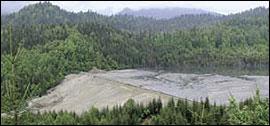 The Baia Borsa-Novat tailing pond is located in a remote mountain valley in Northern Romania. Photograph and caption from International Commission for the Protection of the Danube (ICPDR), Danube Watch at www.icpdr.org/pls/danubis/docs/... |
Melting snow and torrential rains broke a dam at the Baia Borsa lead and zinc mine in Romania, 375 kilometres north-west of Bucharest, on March 10. More than 18,000 tonnes of sediment laden with lead, zinc, copper and a small amount of cyanide entered the Vaser spring and from there flowed into the river Viso, a tributary of the river Tisza. [...] Jim Green, Second Romanian mine disaster adds to river pollution, Green Left Weekly www.greenleft.org.au/back/2000/398/398p23.htm |
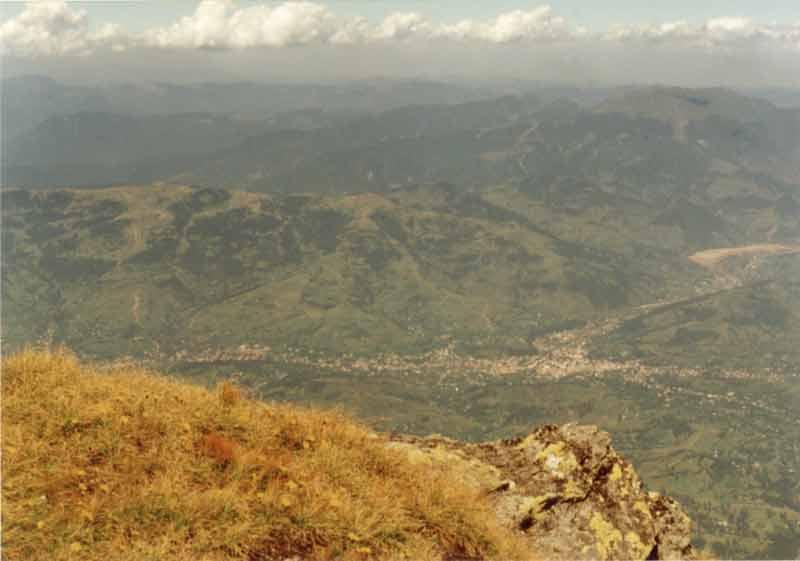 Looking toward the north-east from the 2303 m peak of Pietrosul Rodnei shows Baia Borsa in the valley below, and with Ukraine in the distance, beyond the hills which look down on the valley from the far side. The Tisza River mosaic clarifies Baia Borsa's proximity to the Ukrainian border, and clicking to enlarge the Baia Borsa thumbnail in the mosaic shows Baia Borsa located at X=30 and Y=87, and on the river Tsysla (to use Ukrainian transliteration) or Cisla (to use a spelling that is quoted on the instant page). It is the Cisla which conveys Baia Borsa pollutants to the Viseu, and it is the Viseu which carries them north-west to the Ukrainian border where the Viseu joins the Ukrainian-sourced Tisza, and so on as can be followed in the above-cited Tisza River mosaic. A spill into the Vaser would be even earlier in the chain, the Vaser flowing into the Cisla. The above photograph came from www.suchy.wz.cz/photos/bucovina.htm |
14-Mar-2000 Baia Borsa "Hungarian authorities ordered disaster defence alert along the upper part of river Tisza."
The Third Spill: Baia Borsa Again www.zpok.hu/cyanide/baiamare/thirdstrike.htm |
27-Mar-2000 Baia Borsa "Authorities in Ukraine have expressed concern about another spillage"
ROMANIAN GOLD-MINING COMPANY AGAIN POLLUTES RIVERS duna.org/cyanidespill/4th-spill.shtml |
25-Jul-2000 Baia Mare "Released a large amount of polluted water"
Effluents from Mine Expected to Contaminate Szamos River Hungarian Online Resources duna.org/cyanidespill/other-envtrouble.shtml |
02-Nov-2000 Beius (sometimes "Beiu") "Completely killed off the fish stock of the Nyimest"
River Pollution Kills Fish In Bihor County In Romania Hungarian Online Resources duna.org/cyanidespill/other-envtrouble.shtml |
17-Jan-2001 Falticeni "Some went blue in the face, as is common in cyanide poisoning"
100 HOSPITALISED IN ROMANIA AFTER CYANIDE SPILL KILLS FISH Green Horizon www.rec.org/REC/Programs/MIS/GreenHorizon/GH308.html |
18-Mar-2004 Falticeni "Ten tonnes of cyanhydric acetone leaked from a disused chemical plant into Somuzul Mare"
Romania: cyanide spill pollutes river International Water and Sanitation Centre www.irc.nl/page/9002. Oringinal source, Reuters 18 Mar 2004. Footnotes removed. |
05-Sep-2004 Baia Borsa "Water supplies have been cut off in five towns and villages in the Ukrainian Transcarpathian Region"
Romania Says Heavy Metal Spilled Into North River Mines & Communities Website www.minesandcommunities.org/Action/press429.htm. The geography of the Tisza ("Tisa" in this passage) is incorrect. In fact, the Tisza flows from Ukraine to Join the Viseu at the Ukrainian-Romanian border, and later leaves the border to flow within Ukrainian territory, and so on, as can be seen on the Tisza River mosaic. |
14-Sep-2004 Rosia Poieni "The copper level is 80 times and iron is 28 times the allowed concentration"
|
Rosia Poieni is 4 km from Rosia Montana, and is noted for its copper mine. |
||
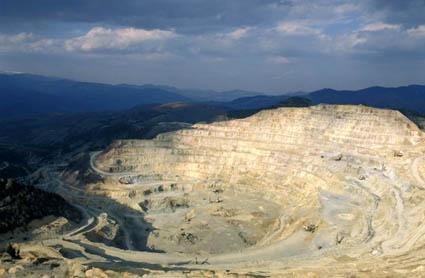 La mine de cuivre de Rosia Poieni à 4km de Rosia Montana (3km de diamètre,300m de profondeur). Photograph and caption are from mchanut.club.fr/rosia.htm. The caption in English might read "Four km from Rosia Montana is the copper mine of Rosia Poieni which is 3 km in diameter and 300 m deep." |
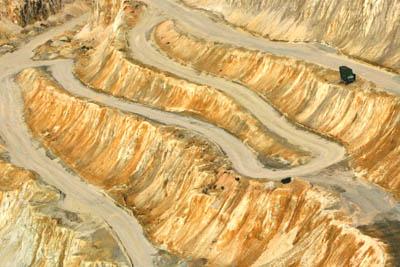 Uncaptioned, from www.jurnalul.ro/modules/pnCPG/coppermine/displayimage.php?album=50&pos;=6 |
|
Stephanie Roth of the Romanian action group, Alburnus Major, comments (on 16th September): Mines & Communities Website www.minesandcommunities.org/Action/press429.htm |
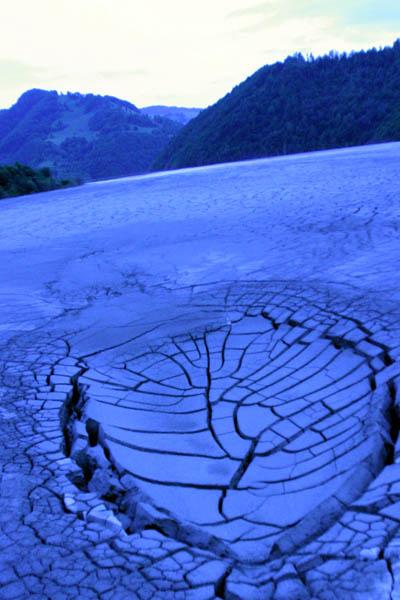 Uncaptioned from www.jurnalul.ro/modules/...
Uncaptioned from www.jurnalul.ro/modules/...
|
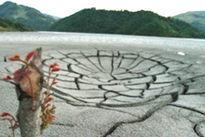 EXTRATERESTRU. Lacul de decantare de la Valea Sesii inseamna de fapt 220 de hectare transformate pe alocuri in peisaj selenar. Photograph and Romanian caption are from
www.jurnalul.ro/modules/.... The caption appears to identify the scene as the dried edge of a decantation lake covering 220 hectares (544 acres) and which gives the appearance of a lunar landscape. By way of comparison, the Rosia Montana cyanide lake is 600 hectares (1,482 acres). By way of further comparison, New York City's Central Park is 341 hectares (843 acres).
EXTRATERESTRU. Lacul de decantare de la Valea Sesii inseamna de fapt 220 de hectare transformate pe alocuri in peisaj selenar. Photograph and Romanian caption are from
www.jurnalul.ro/modules/.... The caption appears to identify the scene as the dried edge of a decantation lake covering 220 hectares (544 acres) and which gives the appearance of a lunar landscape. By way of comparison, the Rosia Montana cyanide lake is 600 hectares (1,482 acres). By way of further comparison, New York City's Central Park is 341 hectares (843 acres).
|